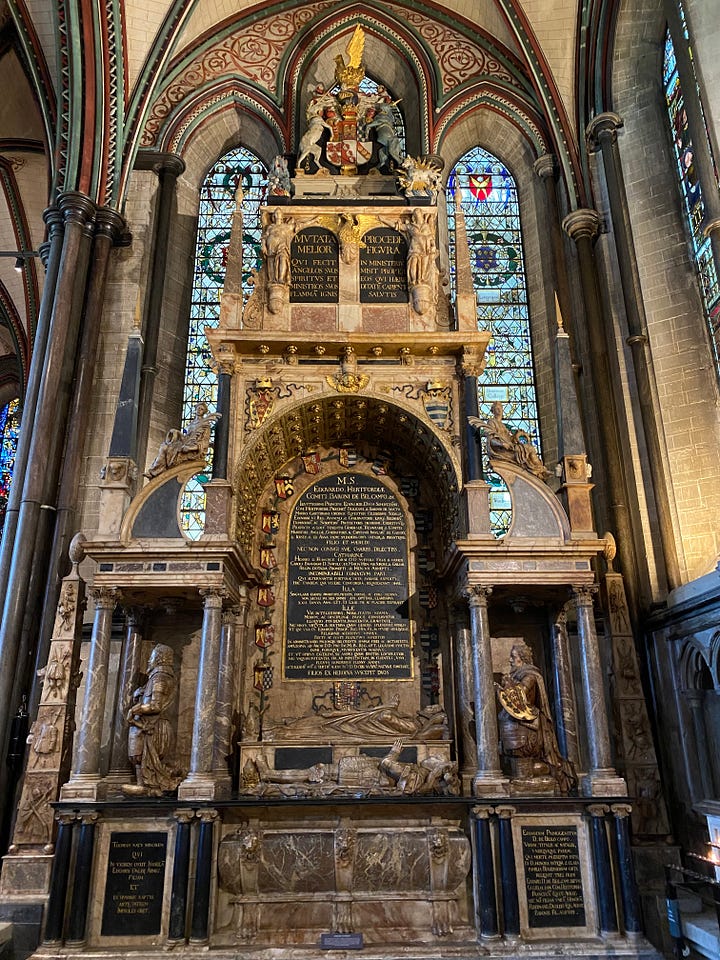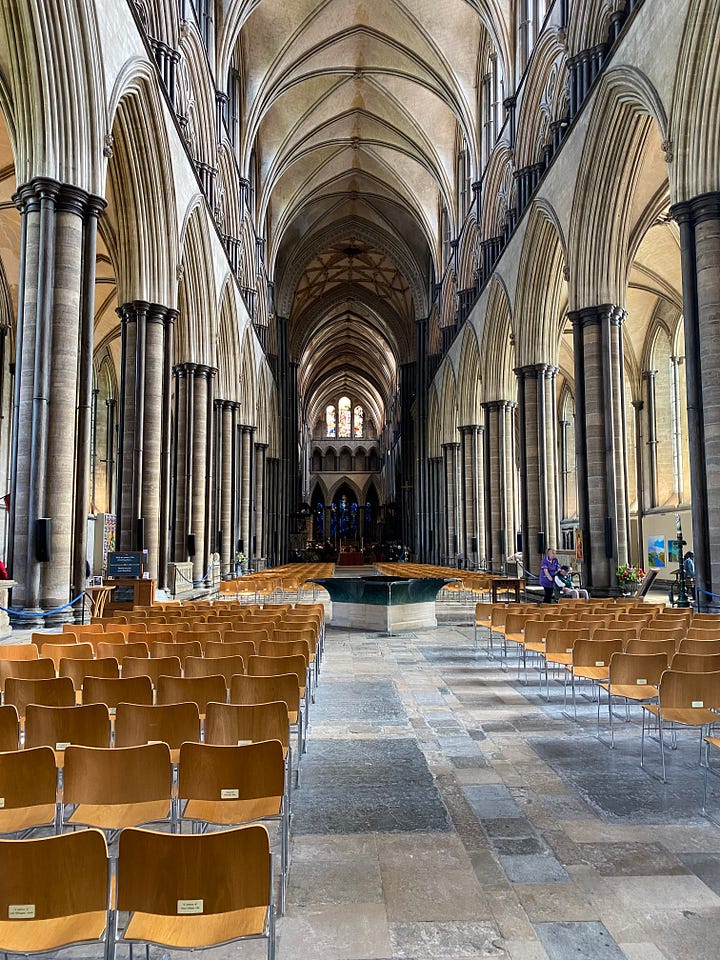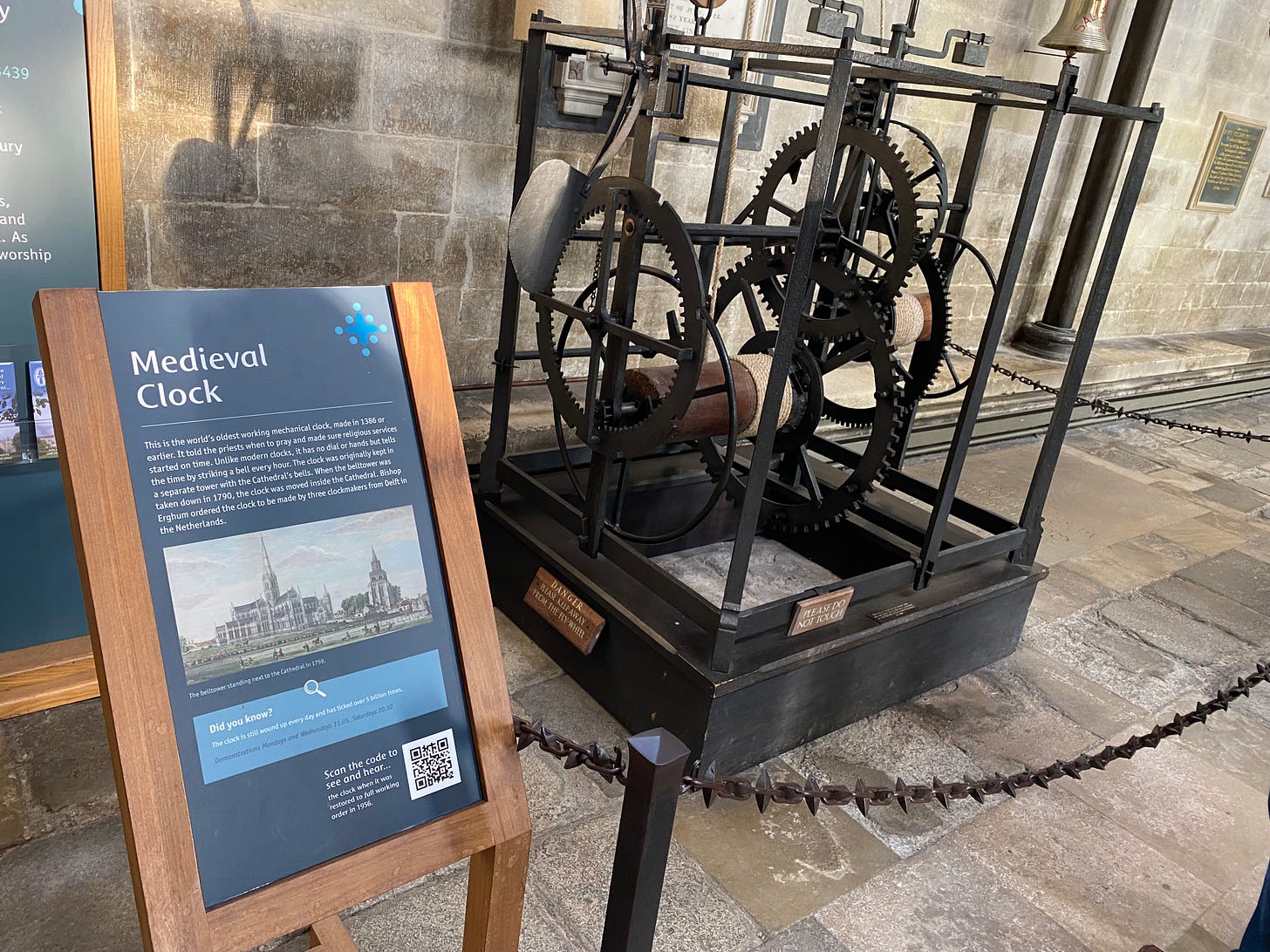You’ll go to see the Magna Carta, I suppose.
Salisbury Cathedral is home to one of four remaining original copies of that famous watershed of modern governance, when King John agreed, in writing, to a few rights for some of his subjects. Salisbury’s is the best preserved of the final four, in fact.
Do that. It is amazing to see.
Others will no doubt be instead drawn to the incredible and awe-inspiring early Gothic architecture of the 800 year-old building. The craft and artistry with which the place is built is truly something to see and left me, a relatively backwaterish American, in reverent silence with a gaping mouth.


I slowly walked through the cathedral trying to take in as much as I could, knowing I didn’t have time to do it all justice. The windows alone deserved a day of devotion.
I did pause to admire what is apparently the oldest working mechanical clock on Earth. Incredible what we were capable of back then, even without apps and AI.
But in the end, all I could really do was wander in a circuitous stupor, letting the textures, colors, smells, and dim, echoing sounds wash across my senses. In the end, my experience was like walking past a great Impressionist’s painting. I allowed myself to be satisfied with the glorious surfaces of the space.
“Peter” and the Persistence of Human Life in Monumental Spaces
The danger of a place like Salisbury Cathedral is that is can become a dead house of greatness. It is filled with mind-boggling human accomplishments of the past and is a shrine; art, history, theology, science, and engineering abound here. But what makes it truly great and magnificent is that is retains its function as a place for humans and humanity.
One of the sounds I picked up on came from the center of the cathedral’s great hall. There was music piping through the great organ and a solemn drone of human voices.
The center chapel was off-limits to tourists that day; we were told that there was a service happening. As my attention was drawn to the human activity I heard, I walked closer and saw that it was a memorial service. There were seats available outside the enclosed worship space, so I took one and quietly sat, took in what I could.
The congregation was there to remember and pay honor to the memory of someone named Peter. Speaker after speaker, in fine, cultured British accents, spoke fondly of the man who will never ever have a last name for me. I felt a measure of guilt as I listened, as if I was an uninvited guest, my very presence being rude. But I was outside the sacred space and assured by a volunteer priest that I was welcome to sit.
I began to feel a great affection for this stranger. The memory he left of himself in those who loved him moved me very deeply. I’ll never know anything about the reality of his life, which was surely as complicated as all our lives. But the story that was immortalized in this service was beautiful and that is what I will take with me.
There were the traditional quotations that one would expect at such a time; a Donne quotation (“No man is an island”). I thought the reading of the poem “Success” by Bessie Anderson Stanley (though the reader misattributed it to Robert Louis Stevenson — most people misattribute it to Emerson, thanks to Dear Abby) was both inspirational and melancholy:
He achieved success who has lived well, laughed often, and loved much;
Who has enjoyed the trust of pure women, the respect of intelligent men and the love of little children;
Who has filled his niche and accomplished his task;
Who has never lacked appreciation of Earth's beauty or failed to express it;
Who has left the world better than he found it,
Whether an improved poppy, a perfect poem, or a rescued soul;
Who has always looked for the best in others and given them the best he had;
Whose life was an inspiration;
Whose memory a benediction.
I am proudly not above pedestrian sentimentality, and I found myself tearing up a bit at the reading — yes, we may have heard this so much that it’s cliché now, but there’s something to aspire to there, isn’t there? Particularly that part about “looking for the best in others” and offering others the same?
By every account I heard, Peter lived this out. The priest who gave the homily focused much on his smiling, joyful eyes that one could see in photos of him, both in his youth and old age. Though the priest made a point to emphasize that Peter had a passion for blunt honesty and that he “didn’t suffer fools.” I felt a kinship when he told of how Peter became enraged at hypocrisy and elitism and slapped it down when he saw it. This is how I will live, as much as it’s up to me.
Eventually, I knew that I was testing the patience of my family, who didn’t travel to England to attend funerals. So I returned to my feet again and took a quick whirl around the rest of Salisbury Cathedral, determined to capture it deeply in my memory.
In the end, I realized that Peter’s memorial service was part of a long tradition. Cathedrals like this are indelibly tied to memorializing the glorious dead.
Many of the artworks in the cathedral are coffins that mark the final resting places of ancient parishioners. Here are two and I wonder if we can’t take something away from the comparison:


In the first, we find an idealized figure, living forever in their most powerful form, the peak of their life. The second shocked me into an admiring giggle. This is no doubt what I would do, if given the opportunity to design my own memorial statue; show myself to the ages as a forever decaying corpse. Thomas Bennett earned massive style points and eternal props for this epic choice.
But in all seriousness. We see two versions of posterity here. One is a stylized rendition of an ideal, timeless self, one is a philosophical account of mortality and the reality of human frailty.
But really, a memorial should combine these two approaches to memory, should they not? Peter’s certainly did. The reading of “Success,” which painted him as a kind and generous man was presented alongside the tales of a passion that sometimes got the best of him. This tension is what defined Peter and one could not exist without the other.
May we all learn something from Peter and Salisbury Cathedral.







Enjoyed your piece. I recall learning about Salisbury Cathedral in my art history textbook. I've gotten to visit some of its brethren like Canterbury and The York Minister, but that was years ago. I remember back then, if you know the band Delirious?, they were doing a concert tour of the U.K. I didn't see them, but the contrast of the modern with the ancient somehow intrigued me though traditional evensongs are amazing. I probably had a similar feeling to you coming from California to the U.K. The oldest relics we have are Spanish missions, and it's hard to explain those to British friends since they somewhat pale in comparison while being centuries younger.
I love this reflection. While I certainly have some sympathy for the concern that the Church has spent such resources to build these monolithic structures, at the same time, they do embody the grandeur and majesty of God, don’t they? They also serve as a kind of memory, an artifact of the Church’s place in a society that would often rather forget. It’s a complex thing, no doubt, but I just can’t help but see these places as sacred and profound.